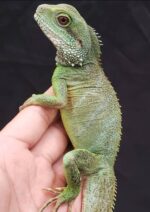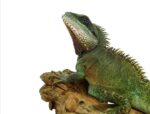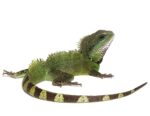Description
Physignathus cocincinus is a species of agamid lizard native to southern China and mainland Southeast Asia. It is commonly known as the Chinese water dragon for sale, Indochinese water dragon, Asian water dragon, Thai water dragon, or green water dragon.
Chinese water dragons are large diurnal lizards adapted for dense subtropical forests replete with unpolluted streams. They are semi-arboreal, roosting at night on branches overlooking streams, which offer an escape route when the lizards are disturbed. Arthropods are their main source of food, though worms, snails, vertebrates, and plants make up a notable portion of the diet as well.
Males are territorial towards each other and bear display features such as crests and jowls. Females are oviparous and reproduce sexually in the wild, though at least one captive Chinese water dragon is known to have reproduced via parthenogenesis.
Physignathus cocincinus is related to Australasian lizards in the subfamily Amphibolurinae. One amphibolurine, the Australian water dragon (Intellagama lesuerii) is so anatomically and ecologically similar to Physignathus cocincinus that it was once (erroneously) placed in the same genus.
Feral populations introduced to Hong Kong and Taiwan flourish in high densities despite countermeasures in the latter territory. Their populations are also stable (albeit not widespread) in protected areas of Thailand.
However, in the rest of their native range, Chinese water dragons have seen sharp population declines in recent decades. They are listed as a Vulnerable species at risk of extinction in the future, based on current trends. The largest threat to the species is overharvesting for meat and the pet trade.
Their meat is in high demand in Vietnam, and captive breeding is currently incapable of replacing wild collection by hunters and poachers. Due to their charismatic appearance, captured Chinese water dragons are sold as pets for both local and international markets.
Yearly exports to the European Union and the United States number in the tens of thousands, all of which are taken from wild populations. Habitat loss is another source of pressure, as undisturbed streamside forest is converted into cropland or subjected to illegal logging and other human activities.
Taxonomy of Chinese Water Dragon For Sale

The species and genus were first described by Georges Cuvier in 1829. Cuvier’s original spelling, ‘Phyhignat,us cocincinus‘, is likely a printing error. The epithet cocincinus is from the French term Cocincine, for the type locality Cochin-china (an exonym of Vietnam).
During the 19th and 20th centuries, several other species of agamid lizards were placed in Cuvier’s genus Physignathus. These have been reclassified into separate genera, leaving Chinese Water Dragon For Sale with only the original species P. cocincinus remaining. For example, the Australian water dragon (Intellagama lesueurii) was known as Chinese Water Dragon for sale for much of its history.











Reviews
There are no reviews yet.